Text within illustrations
We do not capture all text within illustrations,
but do try to capture such text as
- makes sense even without the illustration to explain it;
- helps identify the subject matter of the illustration; or
- makes a potentially useful target for a search
Inside the <FIGURE> tag or outside it? The <FIGURE>
element might be considered a special kind of embedded <DIV>, one
that can function much like a floating ("raisin in oatmeal") <TEXT>
element. Similar 'floating' elements with their own internal structure
include tables and lists. As with tables and lists, one is often
faced with the choice of placing accompanying material (e.g. headings)
either within the object proper, or in near proximity to it in the
surrounding <DIV>. Where to put it is a judgment call: but
bear in mind that
- if the text might help someone identify and find the illustration, it
is usually better to place it within the <FIGURE> tag.
- though it is not a firm rule, one should generally place text that
is engraved as part of the plate within the FIGURE tag, and place
typeset text outside it.
- it is sometimes convenient to treat the illustration and accompanying
material (e.g. a key) as a single FIGURE, even if they spread over
a page opening, and even if some parts of the accompanying material
were typeset separately--especially when the FIGURE (so defined)
acts as a single object floating in a matrix of surrounding text.
Not all text is worth capturing, or is feasible to capture. We
normally omit individual place names on maps (too much work, and often
hard to read); numeric information of all sorts (not likely to be
searched for, and often meaningless without the image to help); arbitrary
markers; and much else that must be decided on a case by case basis.
Capturable text may include:
1. Captions.
Tag as <head> any text that serves to identify or label the
main contents of the illustration,
- whether this is a generic label ("<head>Fig. 1</head>") or something more informative ("<head>Princess Anne in her twenty-second year</head>").
- whether it appears physically at the top of the picture, or at the bottom, or in a panel in one corner, or in a circle around about it.
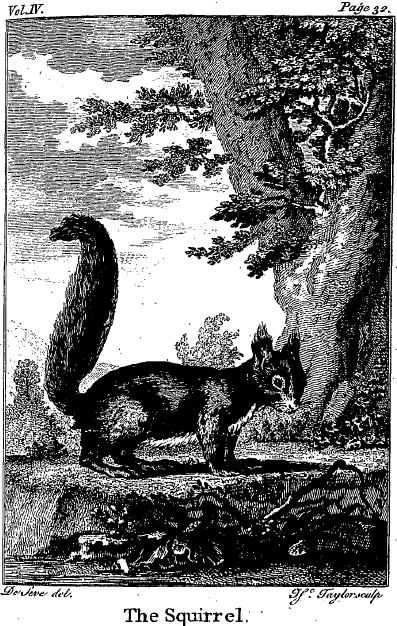 | 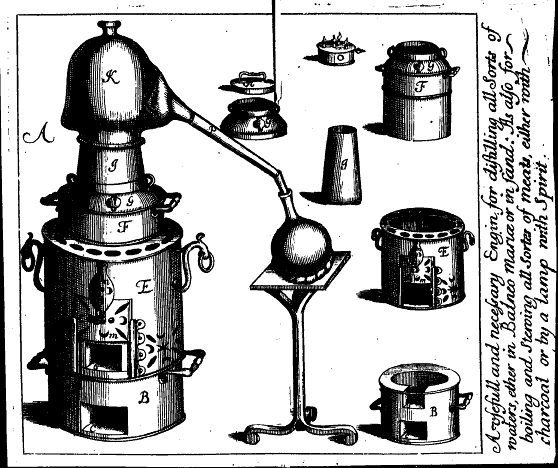 |
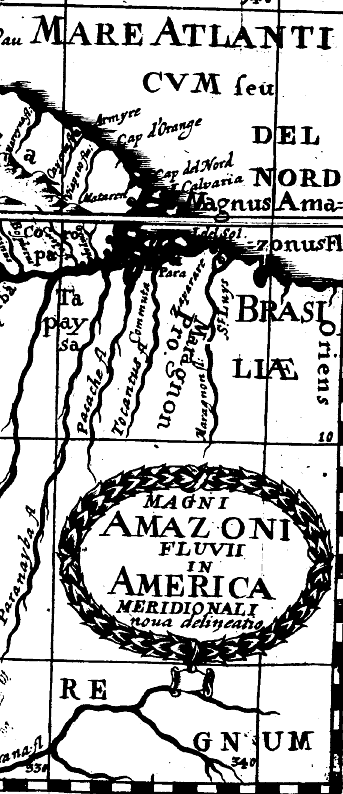 |
<FIGURE>
<FIGDESC>depiction of squirrel</FIGDESC>
<HEAD>The Squirrel.</HEAD>
<P>Vol. IV. Page 32.</P>
<BYLINE>De Seve del.</BYLINE>
<BYLINE>I&s;^c. Taylor sculp</BYLINE>
</FIGURE>
|
<FIGURE>
<HEAD>A v&s;efull and nece&s;sary Engin for di&s;tilling all Sorts of
waters, ether in Balneo Mariae or in &s;and: As al&s;o for
boiling and Stewing all Sortes of meats, either with
charcoal or by a lamp with Spirit.</HEAD>
<FIGURE>
|
<FIGURE>
<FIGDESC>map of Amazon region</FIGDESC>
<HEAD>MAGNI <HI>AMAZONI</HI> FLUVII IN <HI>AMERICA</HI> MERIDIONALI noua delineatio</HEAD>
</FIGURE>
|
2. Attributions
Illustrations (engravings, woodcuts) are often attributed in our
books (admittedly often in small difficult-to-read and abbreviated
phrases), and those attributions may be captured by means of <BYLINE> or
<SIGNED> within <FIGURE>. Typical phrases look like this:
- J. Smith del. ('drew')
- J. Smith delin. ('drew')
- J. Smith sculp. ('engraved')
- J. Smith fecit. ('made')
And they may therefore be tagged like as above:
- <BYLINE>De Seve del.</BYLINE>
- <BYLINE>I&s;^c. Taylor sculp</BYLINE>
Simon Charles adds:
Usu. the name on the left at the bottom of the figure is the artist and
the name on the right craftsmen who engraved/printed the image the
image.
Common abbreviations next to name of artist:
- Del., Del^t., Delin. (L. delineavit) - drew it
- Inv., Inven^t. (L. invenit) - designed it
- Pinx. (L. pinxit) - painted it
Common abbreviations next to name of printer [person who engraved the
plate]:
- Exc. (L. excudit) - executed it
- Imp. (L. impressit) - printed it
- Inc. (L. incidit) - incised it
- Sculp. - engraved it
Common abbreviations next to name of person who both drew the image and
cut/printed it:
- Fec., Fec^t., Fecit., Fac., Faciebat - made it
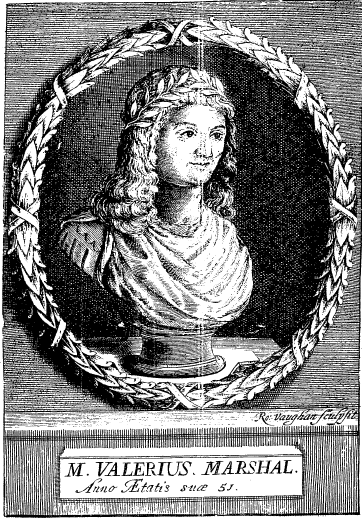 | 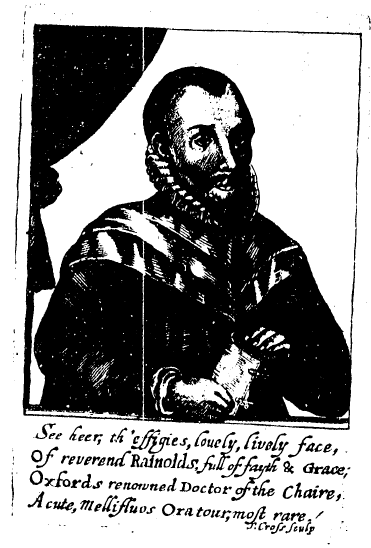 |
<FIGURE>
<FIGDESC>bust of Martial (Marcus Valerius Martialis)</FIGDESC>
<HEAD>M. VALERIUS MARSHAL. Anno Aetatis suae 51.</HEAD>
<BYLINE>Ro. Vaughan &s;culp&sit</BYLINE>
</FIGURE>
|
<FIGURE>
<FIGDESC>portrait of John Rainolds</FIGDESC>
<LG>
<L>See heer; th'effigies, louely, lively face,</L>
<L>Of reverend <HI>Rainolds,</HI> full of fayth & Grace;</L>
<L><HI>Oxford</HI>s renowned <HI>Doctor</HI> of the Chaire,</L>
<L>Acute, mellifluos <HI>Oratour,</HI> mo&s;t rare.</L>
</LG>
<BYLINE>J. Cro&s;s &s;culp</BYLINE>
</FIGURE>
|
3. Mottoes and quotes
Mottoes and epigraph-like text should be captured in <Q> (quote) tags.
4. Keys
Many illustrations (especially maps and diagrams) contain or have in their near proximity a key
to numbered or lettered features. Though capturing the individual markers (e.g. "A" "B") is pointless,
capturing the key is recommended, since it essentially provides a table of contents to the
image. Most of these can be captured as simple <LIST>s.
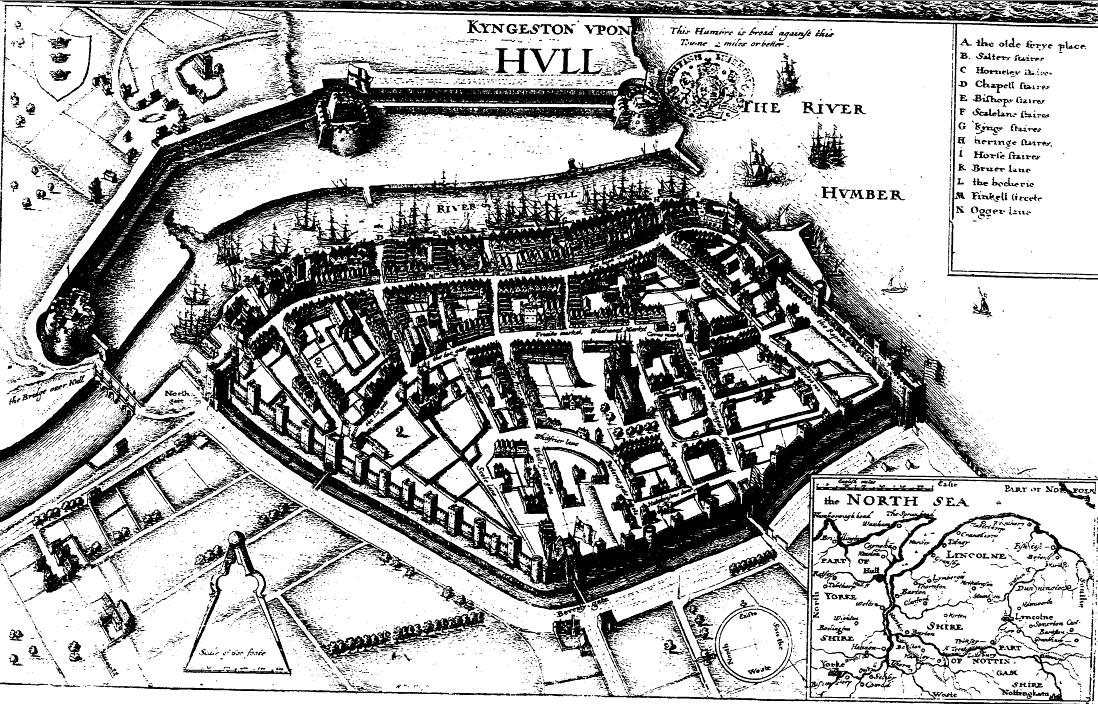 |
<FIGURE>
<FIGDESC>map of Kingston Upon Hull</FIGDESC>
<P>This Humbre is broad again&s;t this Town 3 miles or better.</P>
<P><LIST>
<ITEM>A the olde ferye place</ITEM>
<ITEM>B Salters &s;taires</ITEM>
<ITEM>C Hornely &s;taires</ITEM>
<ITEM>D Chapell &s;taires</ITEM>
<ITEM>E Bi&s;hops &s;taires</ITEM>
<ITEM>F Scalelane &s;taires</ITEM>
<ITEM>G Kyngs &s;taires</ITEM>
<ITEM>H heringe &s;taires</ITEM>
<ITEM>I Hor&s;e &s;taires</ITEM>
<ITEM>K Bruer lane</ITEM>
<ITEM>L the bockerie</ITEM>
<ITEM>M Pinkell &s;treete</ITEM>
<ITEM>N Ogger lane</ITEM>
</LIST></P>
<FIGURE><FIGDESC>inset map of Lincolnshire</FIGDESC>
</FIGURE>
</FIGURE>
|
5. "Speech bubbles"
The ancestor of the modern cartoon 'speech bubble' is not uncommon in early modern engravings.
These can usually be tagged as speeches (<SP>). One sometimes finds the speakers
labelled as well, in which case the labels may be tagged as <SPEAKER>.
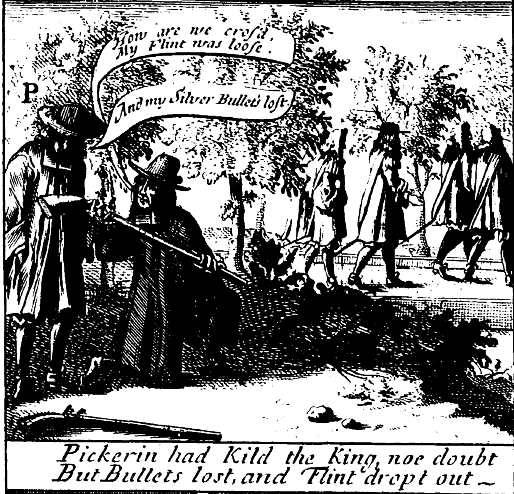 | 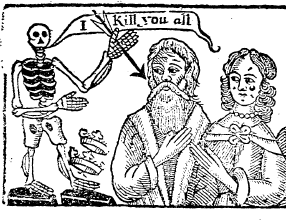 |
<FIGURE>
<SP>
<L>How are we cro&s'd,</L>
<L>My Flint was loo&s;e.</L>
</SP>
<SP>
<SPEAKER>P</SPEAKER>
<L>And my Silver Bullet's lo&s;t.</L>
</SP>
<LG>
<L>Pickerin had Kild the King, noe doubt</L>
<L>But Bullets lost, and Flint dropt out</L>
</LG>
</FIGURE>
|
<FIGURE>
<FIGDESC>memento mori</FIGDESC>
<SP>
<P>I Kill you all</P>
</SP>
</FIGURE>
|
6. Other figures
If an illustration (or a plate) can be construed as containing subordinate
illustrations, do not be afraid to nest <FIGURE> within <FIGURE>.
This is frequently necessary when the subordinate objects have their own captions,
or keys, or other internal structures, or if it is deemed desirable to give them
separate <FIGDESC> tags.
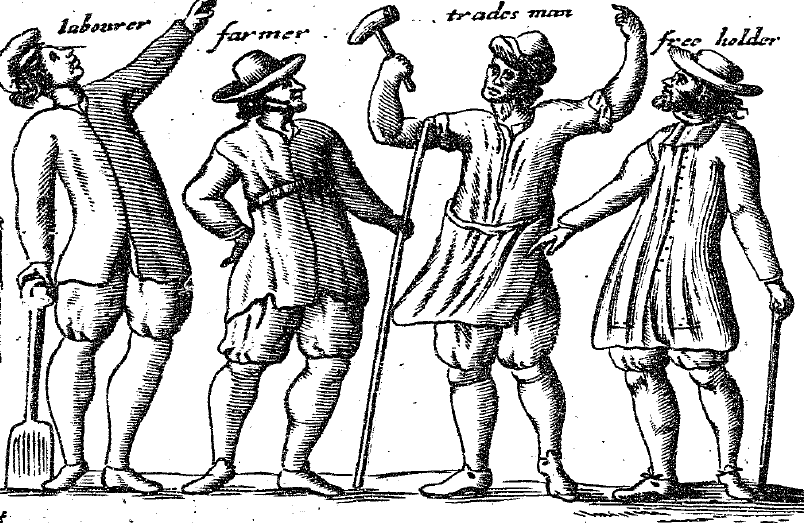 |
<FIGURE>
<FIGURE><HEAD>labourer</HEAD></FIGURE>
<FIGURE><HEAD>farmer</HEAD></FIGURE>
<FIGURE><HEAD>trades man</HEAD></FIGURE>
<FIGURE><HEAD>free holder</HEAD></FIGURE>
</FIGURE>
|
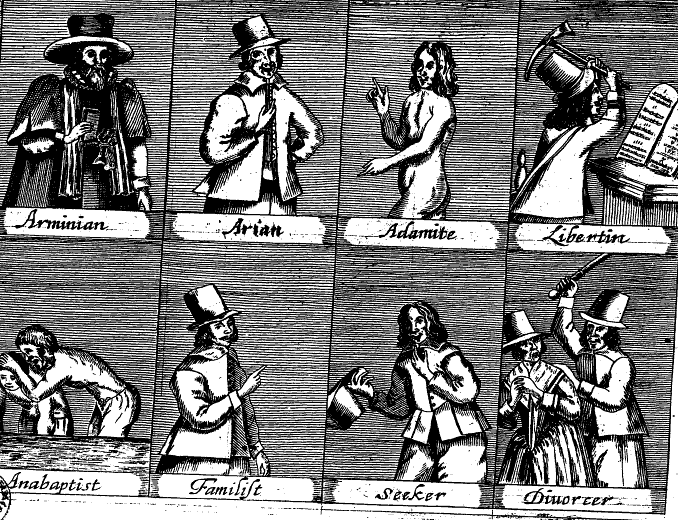 |
7. Complete 'text's
Though the criteria which identify a piece of text as a <TEXT>
in its own right are hard to specify, please be aware that <FIGURE>
can contain <TEXT>, and you may need to capture some items as
<TEXT>s embedded within <FIGURE>. The item does not need
to be long--a complete short poem, for example, might qualify as a <TEXT>--,
but there is rarely need to resort to this unless the item exhibits considerable
internal structure.
8. Text structures graphically presented.
Some illustrations are basically text structures with graphical
adornments, e.g. genealogies portrayed as branches of a tree.
To the extent possible, we should treat the contained text
as we would if the adornments were not there. That is, we
should attempt to represent the intellectual and structural
relationships between the textual parts that are signalled by
the graphics, rather than trying to represent the adornments
themselves. In many cases, however, we may need to fall back
on treating the text as 'miscellaneous prose' (or lists), if
the relationships are more complex or more problematic than
the limited tag set at our disposal allows us to capture.
Capturing such material often requires some ingenuity in
the use of our limited resources, chiefly lists, figdescs, and
embedded figures; and the results usually fall well short of
adequate capture. In such cases, the captured text, though
largely unintelligible, or representing only a single one-dimension
view of a much more complex image, should be seen as providing
keywords for searchers more than interpretation for readers.
In the first example below, the editor has exercisee an ingenuity
bordering on the perverse in capturing what perhaps was beyond
capture. In the second example below, the page was interpreted
as a series of lists, each of them terminating in the
same point (London, marked with a view of London): the
FIGURE was distributed into each of the lists, rather than
the lists all being contained within a FIGURE.
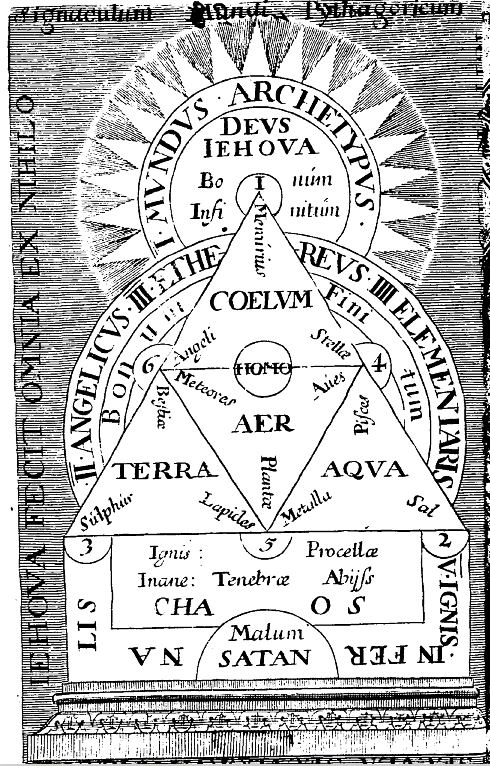 |
<FIGURE>
<HEAD>Signaculum Mundi Pythagoricum</HEAD>
<FIGDESC>diagram of the Pythagorean cosmos</FIGDESC>
<Q>IEHOVA FECIT OMNIA EX NIHILO
<GAP DESC="illegible" REASON="in gutter" RESP="OXF" EXTENT="1 span"> SECVLA SECVLORVM AMEN AMEN</Q>
<P><LIST>
<ITEM>Bonum Infinitum
<LIST>
<ITEM>I · MVNDVS · ARCHETYPVS ·
<LB>DEVS
<LB>IEHOVA
</ITEM>
</LIST></ITEM>
<ITEM>Bonum Finitum
<LIST>
<ITEM>· II · ANGELICVS</ITEM>
<ITEM>· III · ETHEREVS ·</ITEM>
<ITEM>IIII ELEMENTARIS</ITEM>
</LIST>
<FIGURE>
<FIGDESC>diagram of MAN amidst the four elements, represented
as four triangles contained within a single triangle, but
extending beyond the bonum finitum into the realms of bonum
infinitum and malum.</FIGDESC>
<P><LIST>
<HEAD>HOMO</HEAD>
<ITEM>COELVM
<LIST>
<ITEM>1 Mercurius</ITEM>
<ITEM>4 Stellae</ITEM>
<ITEM>6 Angeli</ITEM>
</LIST>
</ITEM>
<ITEM>AQVA
<LIST>
<ITEM>2 Sal</ITEM>
<ITEM>5 Metalla</ITEM>
<ITEM>4 Pi&s;ces</ITEM>
</LIST>
</ITEM>
<ITEM>TERRA
<LIST>
<ITEM>3 Sulphur</ITEM>
<ITEM>5 Lapides</ITEM>
<ITEM>6 Be&s;tia</ITEM>
</LIST>
</ITEM>
<ITEM>AER
<LIST>
<ITEM>6 Meteores</ITEM>
<ITEM>4 Aues</ITEM>
<ITEM>5 Plantae</ITEM>
</LIST>
</ITEM>
</LIST></P>
</FIGURE></ITEM>
<ITEM>Malum
<LIST>
<ITEM>V · IGNIS · INFERNALIS
<LB>SATAN
<LB>Ignis: Procellae Inane: Tenebrae Abij&s;s CHAOS
</ITEM>
</LIST></ITEM>
</LIST></P>
</FIGURE>
|
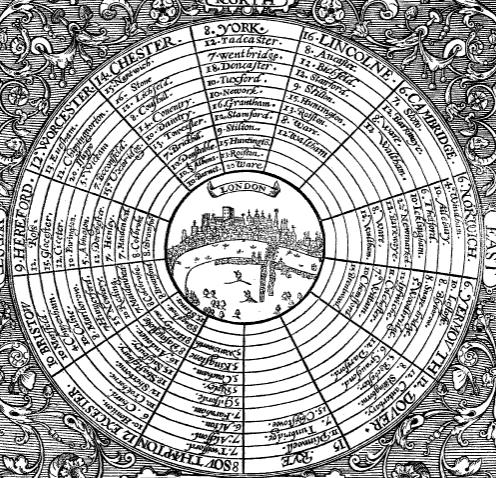
|
<LIST>
<HEAD>NORTH</HEAD>
<ITEM><LIST>
<ITEM>8. YORK.</ITEM>
<ITEM>12. Tadcaster.</ITEM>
<ITEM>7. Wentbridge.</ITEM>
<ITEM>18. Donca&s;ter.</ITEM>
<ITEM>10. Tuxford.</ITEM>
<ITEM>10. Nework.</ITEM>
<ITEM>16. Grantham.</ITEM>
<ITEM>12. Stamford.</ITEM>
<ITEM>9. Stilton.</ITEM>
<ITEM>15. Huntingto~.</ITEM>
<ITEM>13. Roiston.</ITEM>
<ITEM>20 Ware</ITEM>
<ITEM><FIGURE>
<HEAD>LONDON</HEAD>
<FIGDESC>view of London</FIGDESC>
</FIGURE></ITEM>
</LIST></ITEM>
<ITEM><LIST>
<ITEM>16. LINCOLNE.</ITEM>
<ITEM>8. Anca&s;ter.</ITEM>
<ITEM>12. Bichfeld.</ITEM>
<ITEM>12. Stamford.</ITEM>
<ITEM>9. Stilton.</ITEM>
<ITEM>15. Huntington.</ITEM>
<ITEM>13. Roi&s;ton.</ITEM>
<ITEM>8. Ware.</ITEM>
<ITEM>12. Waltham</ITEM>
<ITEM><FIGURE>
<HEAD>LONDON</HEAD>
<FIGDESC>view of London</FIGDESC>
</FIGURE></ITEM>
</LIST></ITEM>
<ITEM><LIST>
<ITEM>6. CAMBRIDGE.</ITEM>
<ITEM>7. Stow.</ITEM>
<ITEM>12. Barkwaye.</ITEM>
<ITEM>8. Ware.</ITEM>
<ITEM>12 Waltham.</ITEM>
<ITEM><FIGURE>
<HEAD>LONDON</HEAD>
<FIGDESC>view of London</FIGDESC>
</FIGURE></ITEM>
</LIST></ITEM>
</LIST>
<LIST>
<HEAD>EAST</HEAD>
<ITEM><LIST>
<ITEM>6. NORWICH.</ITEM>
<ITEM>4. Windham.</ITEM>
<ITEM>10. Atlebury.</ITEM>
<ITEM>6. Thetford.</ITEM>
<ITEM>10. Icklingham.</ITEM>
<ITEM>22. Newmarket.</ITEM>
<ITEM>12. Barkwaye.</ITEM>
<ITEM>8. Ware.</ITEM>
<ITEM>12. Waltham.</ITEM>
<ITEM><FIGURE>
<HEAD>LONDON</HEAD>
<FIGDESC>view of London</FIGDESC>
</FIGURE></ITEM>
</LIST></ITEM>
<ITEM><LIST>
<ITEM>6. YERMOVTH</ITEM>
<ITEM>10. Le&s;toffe.</ITEM>
<ITEM>8. Blyborow.</ITEM>
<ITEM>8. Snaye-bridge.</ITEM>
<ITEM>5. Woodbridge.</ITEM>
<ITEM>12. Ipfwiche.</ITEM>
<ITEM>11. Colche&s;ter.</ITEM>
<ITEM>7. Wittam.</ITEM>
<ITEM>10 Chemfford</ITEM>
<ITEM>15 Brentwood.</ITEM>
<ITEM><FIGURE>
<HEAD>LONDON</HEAD>
<FIGDESC>view of London</FIGDESC>
</FIGURE></ITEM>
</LIST></ITEM>
<ITEM><LIST>
<ITEM>12. DOVER.</ITEM>
<ITEM>12. Canterbary.</ITEM>
<ITEM>8. Stittingborne.</ITEM>
<ITEM>5. Roche&s;ter.</ITEM>
<ITEM>6. Graue&s;end.</ITEM>
<ITEM>12. Dartford.</ITEM>
<ITEM><FIGURE>
<HEAD>LONDON</HEAD>
<FIGDESC>view of London</FIGDESC>
</FIGURE></ITEM>
</LIST></ITEM>
<ITEM><LIST>
<ITEM>15. RYE</ITEM>
<ITEM>11. Plimwell.</ITEM>
<ITEM>7. Tunbridge.</ITEM>
<ITEM>15. Chiy&s;towe.</ITEM>
<ITEM><FIGURE>
<HEAD>LONDON</HEAD>
<FIGDESC>view of London</FIGDESC>
</FIGURE></ITEM>
</LIST></ITEM>
<ITEM><LIST>
<ITEM>8 SOVTHAMPTON</ITEM>
<ITEM>7. Twifford.</ITEM>
<ITEM>7. Alefford.</ITEM>
<ITEM>6. Alton.</ITEM>
<ITEM>7. Farnham.</ITEM>
<ITEM>5 Gilforde.</ITEM>
<ITEM>5 Riyley.</ITEM>
<ITEM>5. Coueham.</ITEM>
<ITEM>5. King&s;tone</ITEM>
<ITEM>5. Wansworth.</ITEM>
<ITEM><FIGURE>
<HEAD>LONDON</HEAD>
<FIGDESC>view of London</FIGDESC>
</FIGURE></ITEM>
</LIST></ITEM>
<ITEM><LIST>
<ITEM>12 EXCESTER.</ITEM>
<ITEM>10. Honiton.</ITEM>
<ITEM>6. Chard.</ITEM>
<ITEM>10. Crokhorne.</ITEM>
<ITEM>12 Sherborne.</ITEM>
<ITEM>18. Shafte&s;bury.</ITEM>
<ITEM>15. Sale&s;bury.</ITEM>
<ITEM>16. Andouer.</ITEM>
<ITEM>8 Ba&s;ing&s;toke.</ITEM>
<ITEM>8 Hartleyrow</ITEM>
<ITEM>8 Bagshott.</ITEM>
<ITEM>15. Stanes.</ITEM>
<ITEM><FIGURE>
<HEAD>LONDON</HEAD>
<FIGDESC>view of London</FIGDESC>
</FIGURE></ITEM>
</LIST></ITEM>
<ITEM><LIST>
<ITEM>10 BRISTOW</ITEM>
<ITEM>10 Mar&s;feld.</ITEM>
<ITEM>4 Chipyenham.</ITEM>
<ITEM>10. Calne.</ITEM>
<ITEM>8. Marlborow.</ITEM>
<ITEM>7. Hungerford.</ITEM>
<ITEM>15 Newbery.</ITEM>
<ITEM>10 Reding.</ITEM>
<ITEM>7. Maidenhed.</ITEM>
<ITEM>8 Colebroke.</ITEM>
<ITEM>8 Bramford</ITEM>
<ITEM><FIGURE>
<HEAD>LONDON</HEAD>
<FIGDESC>view of London</FIGDESC>
</FIGURE></ITEM>
</LIST></ITEM>
</LIST>
<LIST>
<HEAD>WEST</HEAD>
<ITEM><LIST>
<ITEM>9. HEREFORD.</ITEM>
<ITEM>12. Ro&s;s.</ITEM>
<ITEM>15. Gloce&s;ter.</ITEM>
<ITEM>12. Ciceter.</ITEM>
<ITEM>10. Farington.</ITEM>
<ITEM>5. Abington.</ITEM>
<ITEM>12. Dorche&s;ter.</ITEM>
<ITEM>7. Henley.</ITEM>
<ITEM>7. Maidenhed.</ITEM>
<ITEM>8. Colbroke</ITEM>
<ITEM>8. Bramfor^d</ITEM>
<ITEM><FIGURE>
<HEAD>LONDON</HEAD>
<FIGDESC>view of London</FIGDESC>
</FIGURE></ITEM>
</LIST></ITEM>
<ITEM><LIST>
<ITEM>12. WORCESTER.</ITEM>
<ITEM>13. Eue&s;ham.</ITEM>
<ITEM>12. Chippingnorton.</ITEM>
<ITEM>20. I&s;lippe</ITEM>
<ITEM>5. Wickam</ITEM>
<ITEM>7. Becon&s;feld.</ITEM>
<ITEM>15. &V;xbridge.</ITEM>
<ITEM><FIGURE>
<HEAD>LONDON</HEAD>
<FIGDESC>view of London</FIGDESC>
</FIGURE></ITEM>
</LIST></ITEM>
<ITEM><LIST>
<ITEM>14. CHESTER.</ITEM>
<ITEM>15. Nantwich.</ITEM>
<ITEM>16. Stone</ITEM>
<ITEM>12. Lichfeld.</ITEM>
<ITEM>8. Cou&s;hill.</ITEM>
<ITEM>14. Couentry.</ITEM>
<ITEM>10. Daintry.</ITEM>
<ITEM>13. Towce&s;ter.</ITEM>
<ITEM>7. Brickhill.</ITEM>
<ITEM>10. Don&s;table</ITEM>
<ITEM>10. S Albons.</ITEM>
<ITEM>10. Barnet.</ITEM>
<ITEM><FIGURE>
<HEAD>LONDON</HEAD>
<FIGDESC>view of London</FIGDESC>
</FIGURE></ITEM>
</LIST></ITEM>
</LIST>
|
9. Miscellaneous verse and prose and lists
Other useful-looking text within figures can usually be tagged
as <P> (for prose, or at least non-verse); <L> / <LG> (for
verse); and sometimes <LIST> for things arranged in some kind of
series, even if their physical arrangement is not very LIST-like. The
relationships expresses by the physical layout of the figure can occasionally
be suggested by the order in which you capture the text, or by such things
as nesting lists, -- but usually not. Often the best you can do is capture
the text and require the user to look at the original image in order to
make sense, or full sense, of it.
In these two examples I have chosen to make the verse part of the <FIGURE> in the one case, and place it outside the <FIGURE> in the other (because it is engraved as part of the cut in the one case and typeset in the other), but either could have been treated the other way:
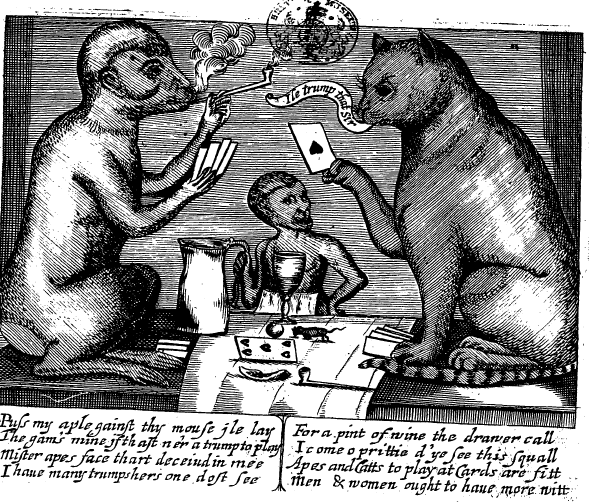 | 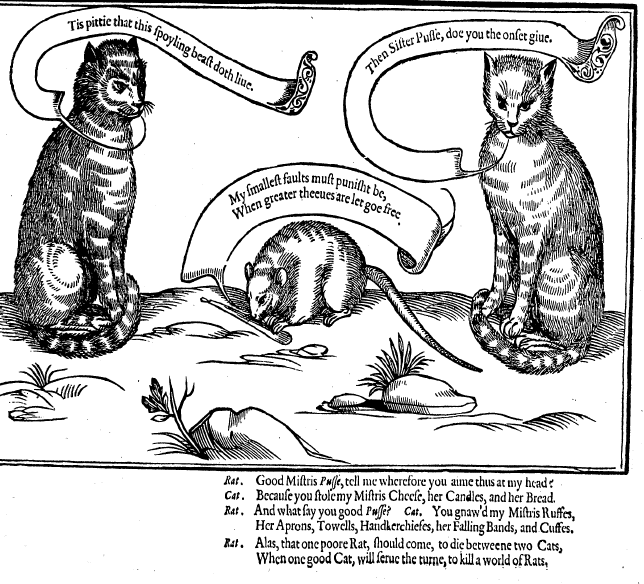 |
<FIGURE>
<SP>
<P>Ile trump that Sir</P>
</SP>
<LG>
<L>Pu&s;s my aple gain&s;t thy mou&s;e jle lay</L>
<L>The gain's mine jf tha&s;t ne'r a trump to play</L>
<L>Mi&s;ter apes face thart deceiud in mee</L>
<L>I haue many trumps hers one do&s;t &s;ee</L>
<L>For a pint of wine the drawer call</L>
<L>I come o prittie d'ye &s;ee this &s;quall</L>
<L>Apes and Catts to play at Cards are fitt</L>
<L>Men & women ought to haue more witt</L>
</LG>
</FIGURE>
|
<FIGURE>
<FIGDESC>depiction of rat between two cats</FIGDESC>
<SP>
<L>Tis pittie that this &s;poyling bea&s;t doth liue.</L>
</SP>
<SP>
<L>Then Si&s;ter Pu&s;&s;e, doe you the on&s;et giue.</L>
</SP>
<SP>
<L>My &s;mallest faults mu&s;t puni&s;t be,</L>
<L>When greater theeues are let goe free.</L>
</SP>
</FIGURE>
<SP><SPEAKER>Rat.</SPEAKER>
<L>Good Mi&s;tris <HI>Pu&s;&s;e,</HI> tell me wherefore you aime thus at my head?</L>
</SP>
<SP><SPEAKER>Cat.</SPEAKER>
<L>Becau&s;e you &s;tole my Mi&s;tris Chee&s;e, her Candles, and her Bread.</L>
</SP>
<SP><SPEAKER>Rat.</SPEAKER>
<L>And what &s;ay you good <HI>Pu&s;&s;e?</HI></L>
</SP>
<SP><SPEAKER>Cat.</SPEAKER>
<L>You gnaw'd my Mi&s;tris Ruffes,</L>
<L>Her Aprons, Towells, Handkerchiefes, her Falling Bands, and Cuffes.</L>
</SP>
<SP><SPEAKER>Rat.</SPEAKER>
<L>Alas, that one poore Rat, &s;hould come, to die betweene two Cats,</L>
<L>When one good Cat, will &s;erue the turne, to kill a world of Rats.</L>
</SP>
|
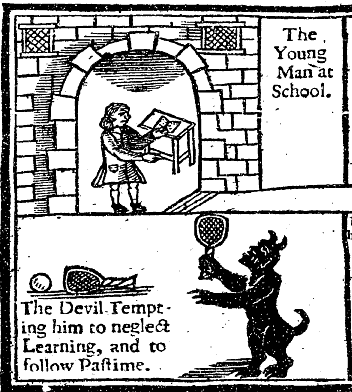 |
<FIGURE>
<FIGDESC>cartoon panel</FIGDESC>
<HEAD>The Young Man at School.</HEAD>
<P>The Devil Tempt|ing him to neglect Learning, and to follow Pa&s;time.</P>
</FIGURE>
|
10. Editor-supplied description (<FIGDESC>s)
Reviewers are encouraged to supply <FIGDESC>s (descriptions)
of pictures if there is anything distinctive or readily describable
in the illustration, especially if there is no caption or the caption
can usefully be supplemented. Remember that if there is no text, or
inadequate text, associated with a FIGURE, the odds are that no one
will ever find it. Most FIGDESCs will consist of a stock phrase,
followed if possible by something more specific, e.g.
- <FIGDESC>map</FIGDESC>
- <FIGDESC>map of India</FIGDESC>
- <FIGDESC>map of London</FIGDESC>
- <FIGDESC>view</FIGDESC>
- <FIGDESC>view of London</FIGDESC>
- <FIGDESC>portrait</FIGDESC>
- <FIGDESC>portrait of Charles II</FIGDESC>
- <FIGDESC>depiction of carpentry tools</FIGDESC>
- <FIGDESC>depiction of Marsh Marigold</FIGDESC>
- <FIGDESC>magnified depiction of house fly</FIGDESC>
- <FIGDESC>Tree of Jesse</FIGDESC>
Try to be
precise, concise, and consistent,
but anything relevant is better than nothing.
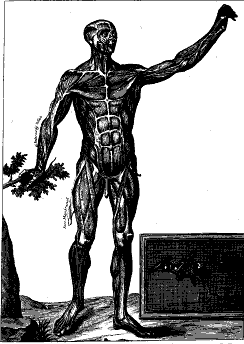 | 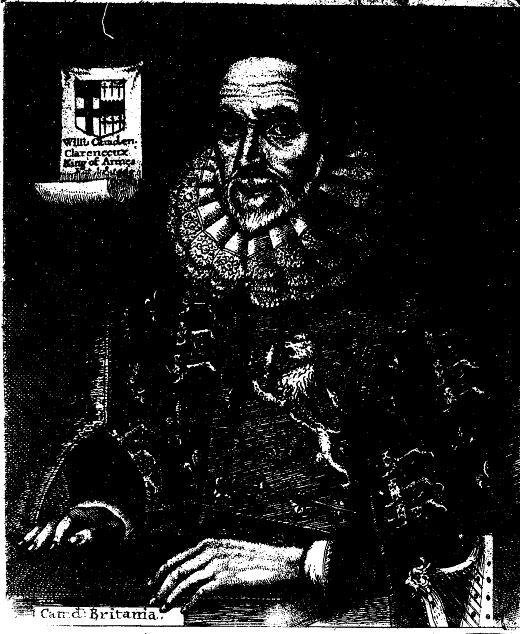 |
<FIGURE>
<FIGDESC>diagram of human musculature, anterior (ventral) view</FIGDESC>
</FIGURE>
|
<FIGURE>
<FIGDESC>portrait of William Camden, incorporating his coat of arms</FIGDESC>
<HEAD>Will: Camden. Clarenceux King of Armes</HEAD>
<FIGURE><FIGDESC>depiction of book</FIGDESC>
<HEAD>Camd: Britania</HEAD>
</FIGURE>
</FIGURE>
|
11. Problem cases: lots of text, little useful
Sometimes it looks like there ought to be useful
text to capture, but it turns out to be too dependent on
the image to be worth pursuing. In that case, a FIGDESC
or short HEAD is enough. In the second example below, we
might have decided also to include the inset table.
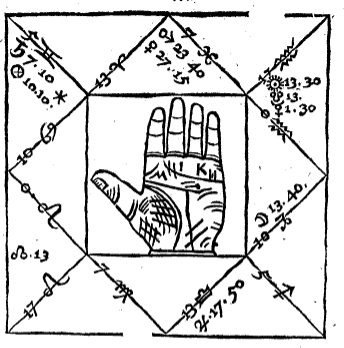 |
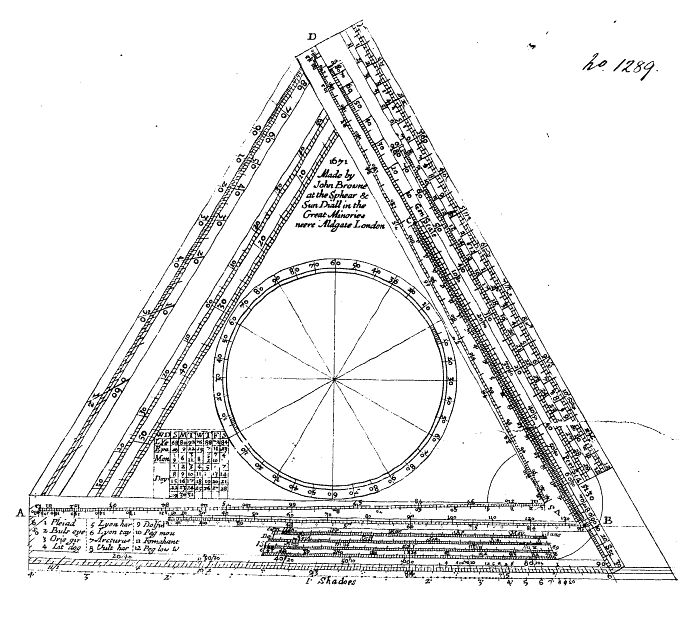 |
<FIGURE>
<FIGDESC>chiromantic diagram</FIGDESC>
</FIGURE>
|
<FIGURE>
<FIGDESC>triangular mathematical instrument</FIGDESC>
<P>1671 Made by John Browne at the Sphear & Sun Diall in the Great Minories neare Aldgate London</P>
</FIGURE>
|


















